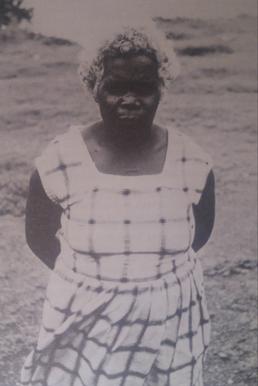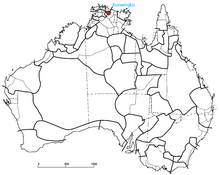
The Yolngu or Yolŋu are an aggregation of Aboriginal Australian people inhabiting north-eastern Arnhem Land in the Northern Territory of Australia. Yolngu means "person" in the Yolŋu languages. The terms Murngin, Wulamba, Yalnumata, Murrgin and Yulangor were formerly used by some anthropologists for the Yolngu.

The Rainbow Serpent or Rainbow Snake is a common deity often seen as the creator God, known by numerous names in different Australian Aboriginal languages by the many different Aboriginal peoples. It is a common motif in the art and religion of many Aboriginal Australian peoples. Much like the archetypal mother goddess, the Rainbow Serpent creates land and diversity for the Aboriginal people, but when disturbed can bring great chaos.

Gunbalanya is an Aboriginal Australian town in west Arnhem Land in the Northern Territory of Australia, about 300 kilometres (190 mi) east of Darwin. The main language spoken in the community is Kunwinjku. At the 2021 Australian census, Gunbalanya had a population of 1,177.

The Iwaidjan or Yiwaidjan languages are a small family of non-Pama–Nyungan Australian Aboriginal languages spoken in the Cobourg Peninsula region of Western Arnhem Land.
Bininj Kunwok is an Australian Aboriginal language which includes six dialects: Kunwinjku, Kuninjku, Kundjeyhmi, Manyallaluk Mayali (Mayali), Kundedjnjenghmi, and two varieties of Kune. Kunwinjku is the dominant dialect, and also sometimes used to refer to the group. The spellings Bininj Gun-wok and Bininj Kun-Wok have also been used in the past, however Bininj Kunwok is the current standard orthography.
Maung is an Australian aboriginal language spoken by the Maung people on the Goulburn Islands, off the north coast of Arnhem Land, in the Northern Territory of Australia. Maung is closely related to Iwaidja language which occupies the northwestern corner of the opposite mainland. This is a language that belongs to the Iwaidjan language family of Non-Pama–Nyungan languages. As of 2021, there were around 360 speakers of the language.
Kunwinjku is a dialect of Bininj Kunwok, an Australian Aboriginal language. The Aboriginal people who speak Kunwinjku are the Bininj people, who live primarily in western Arnhem Land. As Kunwinjku is the most widely spoken dialect of Bininj Kunwok, 'Kunwinjku' is sometimes used to refer to Bininj Kunwok as a whole. Kunwinjku is spoken primarily in the west of the Bininj Kunwok speaking areas, including the town of Gunbalanya, as well as outstations such as Mamardawerre, Kumarrirnbang, Kudjekbinj and Manmoyi.

The Macro-Gunwinyguan languages, also called Arnhem or Gunwinyguan, are a family of Australian Aboriginal languages spoken across eastern Arnhem Land in northern Australia. Their relationship has been demonstrated through shared morphology in their verbal inflections.
The Maung people, or Warruwi, are an Aboriginal Australian people living on the Goulburn Islands, in the Arafura sea off the coast of the Northern Territory.
The Bininj are an Aboriginal Australian people of Western Arnhem land in the Northern Territory. The sub-groups of Bininj are sometimes referred to by the various language dialects spoken in the region, that is, the group of dialects known as Bininj Kunwok; so the people may be named the Kunwinjku, Kuninjku, Kundjeyhmi (Gundjeihmi), Manyallaluk Mayali, Kundedjnjenghmi and Kune groups.
The Gadjalivia were an indigenous Australian people of Arnhem Land in the Northern Territory. They are now regarded as extinct.
The Dalabon or Dangbon are an Australian Aboriginal people of the Northern Territory.
The Arnga are an Aboriginal Australian people of the northern Kimberley region of Western Australia.
The Watta were an indigenous Australian people of the Northern Territory.
The Gambalang are an indigenous Australian people of the Northern Territory.
The Gungorogone are an indigenous Australian people of the Northern Territory.
The Ngormburr, also known as Murumburr and other variants, are an Aboriginal Australian people of the Northern Territory.

Mondalmi was an Aboriginal activist and cultural informant from Australia.

A cleverman is a traditional healer and keeper of culture in many Aboriginal cultures of Australia. The roles, terms for, and abilities of a cleverman vary between different Aboriginal nations. Some clevermen heal bodily injuries and illnesses, while others heal spiritual ailments. They heal using plants, songs, and spiritual knowledge. Exceptionally powerful clevermen are believed to have magical powers and may heal both physical and spiritual ailments. Some sources also refer to clevermen having the ability to kill using magic, although this may be illegal within the culture or a separate form of harmful 'sorcery' from that used by cleverman healers. Clevermen also serve as cultural keepers and are experts in stories and spiritual beliefs. They have a strong understanding of sacred places and lore and a deep connection to the Dreaming. Clevermen may be men or women, depending on the culture.
Mayali or Manyallaluk Mayali is a dialect of Bininj Kunwok, an Australian Aboriginal language. The Aboriginal people who speak Mayali are the Bininj people, who live primarily in western Arnhem Land. Mayali is spoken primarily in south-west Arnhem Land, particularly around Pine Creek, Katherine and Manyallaluk. Occasionally the term "Mayali" is used to refer to all Bininj Kunwok dialects collectively, however this is not generally accepted usage. Speakers of the Kundjeyhmi dialect of Bininj Kunwok often regard Mayali as similar to, or even the same as, Kundjeyhmi.







